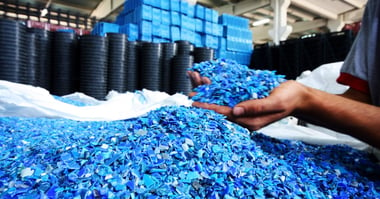
Maura Monaghan
Maura Monaghan has been a digital writer for five years now, covering everything from sustainable ecommerce to types of plastic. She's interested in ecommerce, sustainability, and the ways they can overlap. When she's not writing, she's probably out searching for the perfect cup of coffee.
If you’re wondering how to make your online business more eco-friendly, you’re already ahead of the game. Green business practices are more important than ever, and consumers want to see evidence of sustainable ecommerce wherever they shop.
On this page, we’ve gathered the top seven ways to create a greener online shopping experience, so you can find all the most effective tips in one place.
At CleanHub, we’re committed to helping brands take ownership of their environmental impact. Want to get involved? Partner with us on Shopify, and your business can add a “verified plastic recovery” feature on checkout, show real-time evidence of your impact, and have free marketing tools to kick-start engagement.
What’s on this page?
01 | Top 7 ways Shopify can make your ecommerce business more eco-friendly02 | Is Shopify an eco-friendly platform?
03 | What is sustainable ecommerce?
04 | Summary
05 | FAQs
Top 7 ways Shopify can make your ecommerce business more eco-friendly
Making your ecommerce business more eco-friendly requires some thinking. But there are plenty of small changes you can make, and new strategies you can adopt, to get the ball rolling.
We’ll cover all seven ways in more detail below — but first, a quick look at what you can expect:
|
Rank |
Method |
Description |
|
1 |
Packaging |
Using more eco-friendly materials in your product packaging |
|
2 |
Shipping |
Offsetting your shipping emissions |
|
3 |
Carbon neutral hosting |
Using an eco-friendly web hosting solution |
|
4 |
Provide offsetting options |
Reducing your environmental impact throughout the sales process |
|
5 |
Recycling policies |
Offering recycling programs for reusable packaging |
|
6 |
Returns programs |
Inspiring greener consumer behavior |
|
7 |
Eco-friendly incentives |
Offering rewards for eco-friendly spending decisions |
1. Avoid unnecessary packaging
Goods packaging actually makes up the greatest share of the ecommerce industry’s greenhouse gas emissions, making up roughly 45% of the total.
On the bright side, this means making your packaging greener is one of the most important ways to implement eco-friendly ecommerce. You can do this by using packaging made from renewable or recycled materials, which can be recycled again or even biodegraded after their use.
Aside from choosing greener materials, you can also make some strategic changes to your packaging to produce less waste. For example, non-fragile items won’t need extra padding, so you can eliminate it from products like clothing or books that are unlikely to break in transit.
2. Reduce shipping emissions
The shipping industry emits about 940 million tons of CO2 annually — that’s the equivalent of driving over 200 million gas-powered passenger cars each year.
If your business is using Shopify, you can remove shipping emissions with the Planet app, which lets you offer carbon-neutral shipping on all of your orders.
It works by automatically calculating each order’s estimated shipping emissions. Then, depending on your subscription plan, you’ll pay an average of $0.035 to $0.15 per order to remove carbon from the atmosphere.
You can also make an effort to ship items in bulk. For example, if you’re selling products that a customer might need to replace in the future, why not sell them in multiples rather than just one? Eco-conscious consumers will likely be willing to purchase items like coffee or soap in higher quantities.
3. Try carbon-neutral hosting
Shopify is a website builder, which means it handles most of the more technical aspects of website creation for you – including your web hosting. If you were to build a website on your own from scratch, you’d need to source a web host to provide you with the physical server on which your site and all its data will be stored.
These servers are stored in data centers, which typically require a lot of energy to run — the internet is responsible for about 3.7% of global greenhouse gas emissions (more than the airline industry!), and a very large data center would use around 100 million watts of energy. That’s one-tenth of the output of a thermal power station.
However, Shopify decommissioned its data servers in 2018 and shifted entirely to Google Cloud. This is big for eco-friendly ecommerce on Shopify because Google matches 100% of the energy consumed by Google Cloud with renewable energy, making Shopify’s platform completely carbon neutral.
This is no small feat, considering the average web page produces approximately 0.5 grams of carbon dioxide (CO2) per page view. That means a website with 10,000 monthly page views would generate 60 kg of CO2 per year — the equivalent of driving 154 miles in an average gas-powered car.
4. Provide offsetting options wherever you can
Web hosting isn’t the only area of ecommerce where you can try to offset your environmental impact. In fact, you can provide both carbon and plastic offsetting options at the point of purchase, which is a great way to attract customers who share your values and concern for the planet.
These customers shouldn’t be too difficult to come by, either: one survey saw 66% of respondents say they consider their climate impact when making a purchase.
When you partner with CleanHub on Shopify, your business can add a “verified plastic recovery” feature on checkout, show real-time evidence of your impact, and have free marketing tools to kick-start engagement and spread the word about your offsetting features.
5. Avoid unnecessary returns
Part of running an ecommerce business is having an efficient returns policy in place for your customers.
According to Forbes, a quarter of all consumers say they return at least 5–15% of their online purchases. And the trend isn’t likely to go anywhere, since 38% of consumers became more comfortable with returns during the pandemic. But how can you make those returns more eco-friendly?
The best thing you can do here is to think strategically about the user experience, and what you can do to minimize the amount of unsatisfactory orders that might lead to more returns. Prevention is the best medicine!
For example, if you’re running a clothing brand, can you give users more accurate sizing information? Kiwi Size Chart & Recommender is one app offered in the Shopify store that helps to reduce returns by using machine learning to create a personalized size recommendation tool and product-specific size guides.
6. Encourage recycling
Once you’ve started packaging your products with biodegradable and/or recyclable materials, you might also want to consider starting a returns program for empty, reusable containers.
For example, if you send out liquids or food products in glass or aluminum containers, you can give your customers the option to send their empties back to be sterilized and reused.
Lush is one company already encouraging customers to bring plastic packaging back to their shops to be recycled. Lush’s “Bring it Back” scheme saw 720,000 items returned in 2022 alone, and they offer rewards including a 50p discount for each item brought back.
Programs like this mean both you and your customers can feel even better about your product packaging, and you can offer people a chance to participate in more eco-friendly behavior to reduce plastic pollution.
7. Create eco-friendly incentives
It’s true that many consumers are looking to support eco-friendly ecommerce businesses. According to one study, 87% of consumers want brands to act now to encourage future sustainability. Still, it doesn’t hurt to encourage greener purchase decisions where you can!
One way you can do this is by offering a reward when customers take an eco-friendly action, such as a discount on their next purchase for customers who participate in your recycling returns program.

Is Shopify an eco-friendly platform?
It’s no secret that most businesses are trying to build themselves a more eco-friendly image these days. This action is in response to a climate in which 84% of consumers say that poor environmental practices will alienate them from a company.
But how can you distinguish the businesses that are truly making an effort from those that are just in it for the optics? We’ve identified some of the more impressive aspects of Shopify’s climate strategy below, as an example of a company that’s doing the former successfully.
Connecting its mission to the environment
Shopify calls itself “the entrepreneurship company,” with a mission of helping anyone start and scale a business, regardless of experience.
Now, the mission could stop there, but we like that Shopify instead goes on to acknowledge the link between these efforts and the planet: “Commerce can only thrive in the long-term if our planet thrives too.”
This connection is a solid strategy to consider if you’re looking to craft your own brand’s mission statement, too!
Holding itself to account
It’s easy to make empty promises. But by recording and publicizing the climate goals that it had set in years past, Shopify makes it easy for consumers to measure the company’s progress against those previous benchmarks.
Plus, it’s no small feat that Shopify has actually achieved a lot of its climate goals in recent years, including a commitment to spend $5 million annually on “the most promising, impactful technologies and projects fighting climate change globally.”
Helping its customers make a difference
It’s one thing for a company to publicize its own eco-friendly successes, but it’s even better when that company’s small business customers can make the most of its resources as well. Shopify offers plenty of tools to help ecommerce businesses up their green game, including access to sustainable printing materials and help with carbon-neutral shipping.
What is sustainable ecommerce?
Sustainable ecommerce refers to the practice of selling goods and/or services online with a particular emphasis on mitigating the environmental impact of such sales.
Given that sustainability involves the effort of putting less pressure on natural resources, and that shopping encourages consumption, the two words put together can raise a few questions.
The value of the phrase sustainable ecommerce depends on who’s using it, because some companies genuinely try to live up to their promises while others tend to greenwash.
Want to learn more? Check out our detailed guide: What Is Sustainable Ecommerce — And How Can It Benefit Your Business?
Summary: Partner with CleanHub on Shopify
Trying to make your ecommerce business more eco-friendly is a noble goal, and the good news is that there are plenty of tools and strategies out there to help you do it successfully.
CleanHub is dedicated to helping brands take ownership of their environmental impact. If you’d like to get involved, Partner with us on Shopify – your business can add a “verified plastic recovery” feature on checkout, show real-time evidence of your impact, and have free marketing tools to kick-start engagement.
FAQs
What is eco-ecommerce?
Eco-ecommerce and eco-friendly ecommerce are one and the same. It means ecommerce that takes into account the environmental impact of online shopping, and actively tries to lessen that impact through a number of strategies, from offsetting carbon emissions to using recyclable packaging materials.
What are eco-friendly websites?
Eco-friendly websites are websites that don’t negatively impact the environment. This can be achieved by using carbon-neutral web hosting and taking green action (for example, funding plastic recovery or applying for a packaging assessment through CleanHub) for every equivalent amount of carbon emitted.
Why is ecommerce more sustainable?
Ecommerce can be made more sustainable when key aspects of it are changed to have less of an impact on the environment. You can do this by revamping your business strategy to encourage greener behaviors and the use of more recyclable materials.

.webp)

.webp?width=380&name=Plastic-on-the-beach%20(1).webp)

.webp?width=380&name=Ecommerce-business-owner%20(1).webp)
.webp?width=380&name=ESG-presentation%20(1).webp)


.webp?width=380&name=recycling%20(1).webp)
.webp?width=380&name=Sustainable%20christmas%20(1).webp)

.webp?width=380&name=Sales%20(1).webp)
